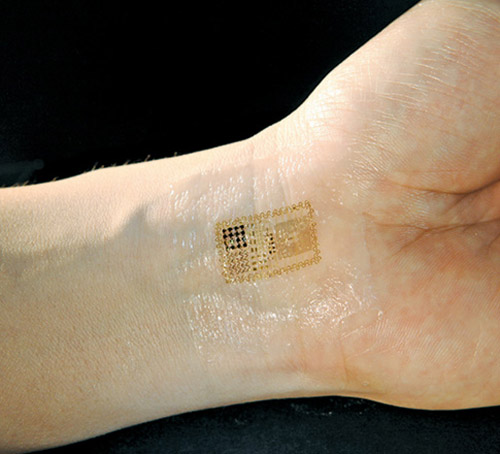We are all familiar with children’s favourite tattoo stickers of He-man and Spider-man that can be easily affixed to the skin. Now technology has advanced to such an extent that electronic components could be affixed to the skin just like a tattoo sticker while remaining almost invisible to the user. These thin, sticker-like tattoos, called electronic skin patches, mark a major breakthrough in human-machine interfaces.
The team behind this technology includes researchers from the University of Illinois at Urbana-Champaign along with members of various other universities and institutions. The system developed by them integrates with the skin in such a way that it is mechanically and physiologically out of sight to the user. Called epidermal electronic system (EES), it can affix a component over the outer skin (epidermis).
What goes inside
The device is made of circuits with components such as LEDs, tiny transmitters, sensors and receivers, and networks of wire filaments crafted carefully. These filaments help the device to be twisted, bent in any angle or deformed—just like the skin.
Such self-adhesive, very thin electronic devices can be used in the field of health care for heart rate, brain wave, muscle activity and blood flow monitoring.
“Human skin is rough, but our electronics is now able to follow the skin morphology and adhere like a temporary tattoo,” said Joseph Cummings, professor at Northwestern’s McCormick School of Engineering and Applied Science.

An electronic skin patch (Image courtesy: www.smartplanet.com)
EES offers the opportunity to seamlessly apply sensors with negligible power and no weight and no cables or wires (externally). The epidermal electronic circuit is built up on an ultra-thin leaf of soluble plastic and affixed onto the skin with any water-like solution, just like a removable tattoo.
The trick of fabricating very thin silicon for flexibility applies to the polydimethylsiloxane (PDMS) polymer substrate as well. PDMS effectively manages to apply the tiny components to skin while helping to undergo bending and stretching. In normal conditions, the inflexible silicon element can be avoided by integrating the active components that interconnect themselves.
“We are trying to bridge that gap, from silicon, wafer-based electronics to biological, ‘tissue-like’ electronics, to really blur the distinction between electronics and the body,” says John Rogers, University of Illinois. Rogers and his colleague Yonggang Huang strongly believe that tattoo technology can assist in detecting serious health problems such as strokes and cardiac arrest.
The challenge before the researchers was to develop an electronic system with the thickness and stringency similar to skin. The researchers achieved this by using a serpentine pattern of nanoribbons. The EES is constructed with flat components, which are integrated into the polyester that is 40- to 50-microns thick—thinner than human hair.
“The design enables fragile, inorganic semiconductors to achieve extremely vast stretchability and flexibility. Plus, the serpentine design is very useful for self-adhesion to any surface without using glues,” explains Yonggang Huan.
In the future
Currently, to get the brain function analysis or EEG done, a person needs to go to a clinical laboratory setting and wear a type of helmet. With EES, this analysis could be possible in any environment or situation.
Rogers informs that this technology could be used for a variety of medical applications, preferably as sensors that could closely monitor the heart functioning and muscular activities, which are presently being monitored using wires and conductive gels.
Using this technology, researchers have measured electrical signals produced by the brain, heart and muscles, of various patients and people under different conditions. They claim the technology to play a major role in the future of health care.
For more exciting Tech Focus article
The author is an associate professor at Mar Thoma Institute of Information Technology, Department of Computer Applications, University of Kerala






